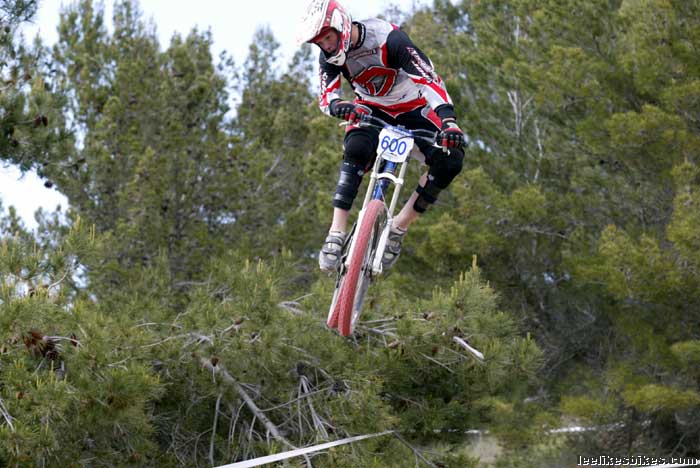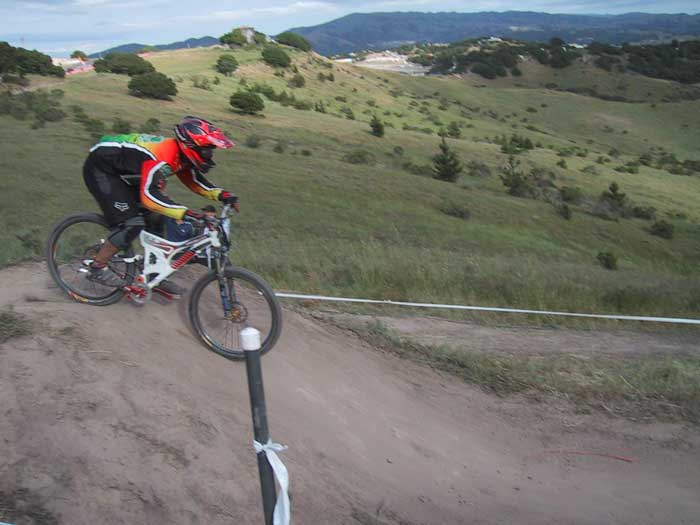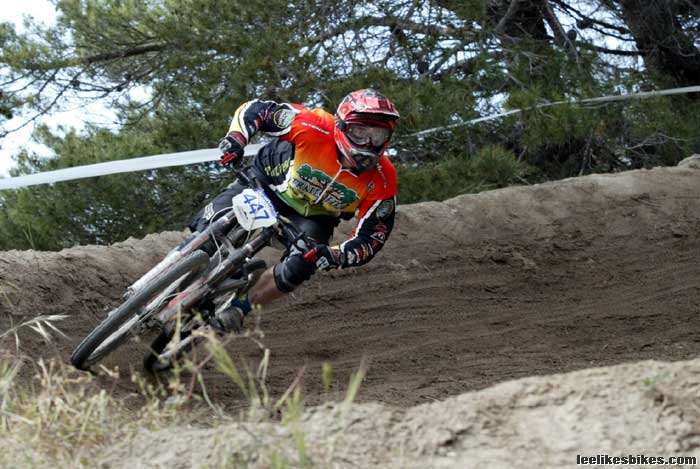Questions about Sea Otter DH

This is Evan’s first try. He wants to know which bike to run, how big the jumps are, etc.
|
The more you click, the more I can post. Lee Likes Groceries dot com! |
Lee,
First, let me say I’m stoked that you’re offering so much good advice on your web site and I also loved the mastering mtb skills book. It’s hard to explain in textbook format an art such as mountain biking, but you’ve done the best job of it I’ve seen yet. Props and thanks.
 The jumps at the top of the course will boost you — if that’s what you want. |
So let me get right to it since I’m sure I’m not the only one emailing you for advice ;). I’ve been riding for two years and have progressed rather fast. I have a BMX background, natural skills, yada yada and have surpassed my friends who have been riding longer than me. Just trying to paint you a picture here. I entered myself in this year’s Sea Otter DH Beginner 25 – 29 (I’m 27) and this will be not only my first race as a racer but also as a spectator (other than my volunteer work at Crankworx this year). I have a general idea for what to expect, so I’m looking more for details such as the following:
– My main ride is a VP-Free with a Fox 40; too big for the course, right?Unless I’m Heman, which I’m not. How would my stepdad’s Blur LT fair? I’m guessing the Nomad would be better, huh?
– I can go ride the basic course route now, right?
– How do they modify the course? They add jumps and berms and stuff, right? So my practice runs in Feb and Mar will get me acquainted with the route, but the course will pretty much be completely reworked come race time?
– How big are the jumps on this thing? I’m looking at the course map and it just says “jump”, “fancy hip jump”, etc not too helpful. I can go sorta big, but I want to make sure I’m not getting in over my head.
– Is it usually 60 sec intervals the riders are released at?
Any other tips you have would be sweet. Thanks again. And I’ll look for you so I can thank you in person at SO this year!
Rgds,
Evan
Hey Evan,
Welcome to the club. Your BMX will serve you well, my son.
 Me pumping the back of Jump No. 3 on the SX. Circa 2004. |
Bike choice
As my friend Ross McMahon says, “If you have the power, the big bike is always faster.” A few years ago I did back-to-back, helmet-cammed runs on my SX (4″) and my Demo 9 (9″). I swore the SX was faster — until we reviewed the tapes. The SX felt faster because it was sketchy! Where I was bouncing on the SX, I was pedaling on the Demo 9. I decided to run the Demo, with WTB Weir Wolf 2.3 in front and an Epic Wolf 2.1 in back. The bike rolled superfast and got plenty of traction. And I won my expert class!
People do well on all kinds of bikes. Run whatever you’re comfortable on. If you usually ride your VP-Free, that’s the bike to race. Last year I raced an Enduro, and that worked well too. Mid-pack semipro.
The course
I’m not so sure you can ride the course. Don’t bother. You can memorize it at the race. Use your time to train near home.
The jumps aren’t very big (but that’s relative!). The tables up top are maybe 10-15 feet, and the “fancy hip jump” is about 15 feet. It looks scary, but if you carry good speed out of the corner, it’s almost automatic. There’s a go-around, but it would cost you.
Beginners race in 20-30 second intervals.
 Me railing the first berm on the Demo 9. The big bike hooks up like crazy! BTW: My Demo 9 was 41 pounds with ti spokes and lots of other funny business. |
Preparation
Sea Otter DH is a mix of corners, jumps and pedaling. Ride XC. Do one-minute all-out intervals (to simulate the flat, pedaly finish). Practice jumping at the BMX track or dirt jumps. If you want to race fast, you must train fast.
You can win beginner by 1) carrying decent speed through the corners, 2) getting over the jumps cleanly and 2) pedaling like a maniac.
More
Yeti-FOX Racing Factory Team Weathers Sea Otter Storm – bike setup
Sea Otter Circus ’04 – detailed description of the course

Comments are closed.